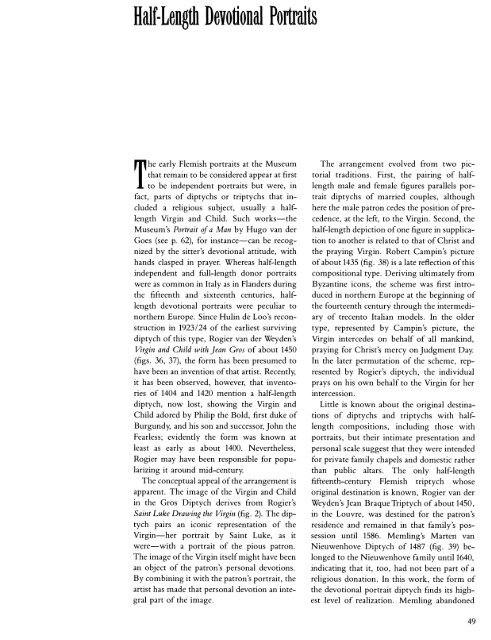Early Flemish Portraits 1425-1525: The Metropolitan Museum of Art ...
Early Flemish Portraits 1425-1525: The Metropolitan Museum of Art ...
Early Flemish Portraits 1425-1525: The Metropolitan Museum of Art ...
You also want an ePaper? Increase the reach of your titles
YUMPU automatically turns print PDFs into web optimized ePapers that Google loves.
Half-Length Devotional <strong>Portraits</strong><br />
he early <strong>Flemish</strong> portraits at the <strong>Museum</strong><br />
that remain to be considered appear at first<br />
to be independent portraits but were, in<br />
fact, parts <strong>of</strong> diptychs or triptychs that included<br />
a religious subject, usually a halflength<br />
Virgin and Child. Such works-the<br />
<strong>Museum</strong>'s Portrait <strong>of</strong> a Man by Hugo van der<br />
Goes (see p. 62), for instance-can be recognized<br />
by the sitter's devotional attitude, with<br />
hands clasped in prayer. Whereas half-length<br />
independent and full-length donor portraits<br />
were as common in Italy as in Flanders during<br />
the fifteenth and sixteenth centuries, halflength<br />
devotional portraits were peculiar to<br />
northern Europe. Since Hulin de Loo's reconstruction<br />
in 1923/24 <strong>of</strong> the earliest surviving<br />
diptych <strong>of</strong> this type, Rogier van der Weyden's<br />
Virgin and Child with Jean Gros <strong>of</strong> about 1450<br />
(figs. 36, 37), the form has been presumed to<br />
have been an invention <strong>of</strong> that artist. Recently,<br />
it has been observed, however, that inventories<br />
<strong>of</strong> 1404 and 1420 mention a half-length<br />
diptych, now lost, showing the Virgin and<br />
Child adored by Philip the Bold, first duke <strong>of</strong><br />
Burgundy, and his son and successor, John the<br />
Fearless; evidently the form was known at<br />
least as early as about 1400. Nevertheless,<br />
Rogier may have been responsible for popularizing<br />
it around mid-century.<br />
<strong>The</strong> conceptual appeal <strong>of</strong> the arrangement is<br />
apparent. <strong>The</strong> image <strong>of</strong> the Virgin and Child<br />
in the Gros Diptych derives from Rogier's<br />
Saint Luke Drawing the Virgin (fig. 2). <strong>The</strong> diptych<br />
pairs an iconic representation <strong>of</strong> the<br />
Virgin-her portrait by Saint Luke, as it<br />
were-with a portrait <strong>of</strong> the pious patron.<br />
<strong>The</strong> image <strong>of</strong> the Virgin itself might have been<br />
an object <strong>of</strong> the patron's personal devotions.<br />
By combining it with the patron's portrait, the<br />
artist has made that personal devotion an inte-<br />
gral part <strong>of</strong> the image.<br />
<strong>The</strong> arrangement evolved from two pictorial<br />
traditions. First, the pairing <strong>of</strong> half-<br />
length male and female figures parallels portrait<br />
diptychs <strong>of</strong> married couples, although<br />
here the male patron cedes the position <strong>of</strong> precedence,<br />
at the left, to the Virgin. Second, the<br />
half-length depiction <strong>of</strong> one figure in supplication<br />
to another is related to that <strong>of</strong> Christ and<br />
the praying Virgin. Robert Campin's picture<br />
<strong>of</strong> about 1435 (fig. 38) is a late reflection <strong>of</strong> this<br />
compositional type. Deriving ultimately from<br />
Byzantine icons, the scheme was first introduced<br />
in northern Europe at the beginning <strong>of</strong><br />
the fourteenth century through the intermediary<br />
<strong>of</strong> trecento Italian models. In the older<br />
type, represented by Campin's picture, the<br />
Virgin intercedes on behalf <strong>of</strong> all mankind,<br />
praying for Christ's mercy on Judgment Day.<br />
In the later permutation <strong>of</strong> the scheme, represented<br />
by Rogier's diptych, the individual<br />
prays on his own behalf to the Virgin for her<br />
intercession.<br />
Little is known about the original destinations<br />
<strong>of</strong> diptychs and triptychs with halflength<br />
compositions, including those with<br />
portraits, but their intimate presentation and<br />
personal scale suggest that they were intended<br />
for private family chapels and domestic rather<br />
than public altars. <strong>The</strong> only half-length<br />
fifteenth-century <strong>Flemish</strong> triptych whose<br />
original destination is known, Rogier van der<br />
Weyden's Jean Braque Triptych <strong>of</strong> about 1450,<br />
in the Louvre, was destined for the patron's<br />
residence and remained in that family's possession<br />
until 1586. Memling's Marten van<br />
Nieuwenhove Diptych <strong>of</strong> 1487 (fig. 39) belonged<br />
to the Nieuwenhove family until 1640,<br />
indicating that it, too, had not been part <strong>of</strong> a<br />
religious donation. In this work, the form <strong>of</strong><br />
the devotional portrait diptych finds its highest<br />
level <strong>of</strong> realization. Memling abandoned<br />
49

















